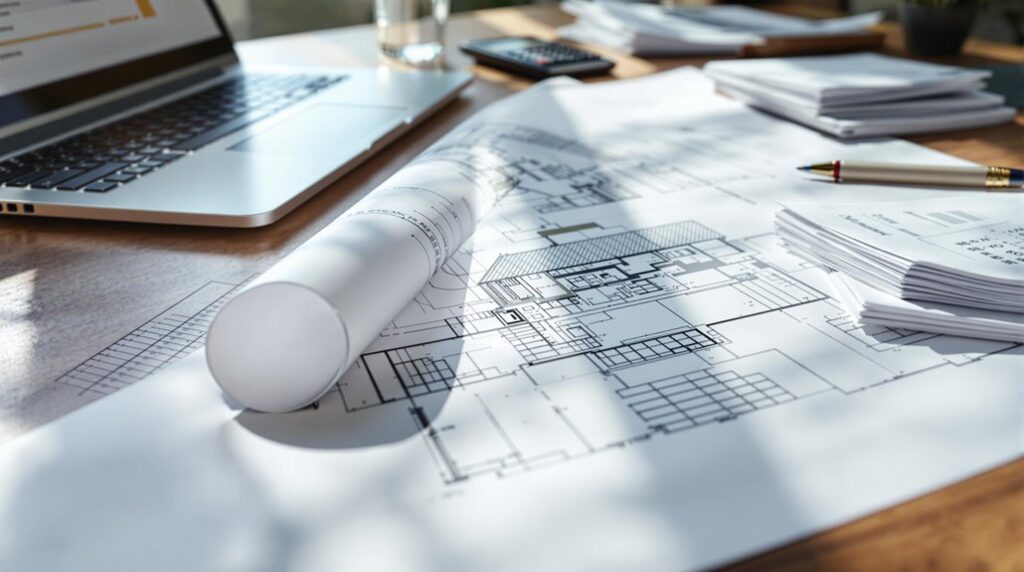I’ll walk you through the most overlooked opportunity in UK construction—VAT reclaim schemes that can slash your project costs by thousands. Most builders and self-builders don’t realize they’re entitled to significant refunds on qualifying materials and services, simply because they haven’t mapped out which items qualify and when to claim them. The difference between a successful claim and a costly rejection often comes down to understanding three critical factors that separate the winners from those who miss out entirely.
Key Takeaways
- VAT-registered builders and self-build homeowners can reclaim VAT on qualifying materials and contractor services for personal residential projects.
- Structural materials like bricks, timber, roofing, plumbing systems, electrical installations, and built-in joinery components qualify for VAT reclaims.
- Household appliances, furniture, tools, and decorative items are excluded from VAT reclaim eligibility and cannot be claimed.
- Submit VAT431 form within 6 months of completion with proper invoices and completion certificates to avoid forfeiting your refund.
- Strategic planning includes buying zero-rated materials early, sourcing from VAT-registered suppliers, and utilizing 5% rates on energy-saving products.
Understanding VAT Reclaim Eligibility for UK Construction Projects

When commencing on UK construction projects, understanding VAT reclaim eligibility can greatly impact your project’s financial outcome. I’ll guide you through the key eligibility criteria that determine whether you can reclaim VAT on your construction expenses.
You’re eligible if you’re a VAT-registered builder charging VAT to clients, or a self-build homeowner under the DIY Housebuilders Scheme. Charities constructing communal housing projects and self-employed contractors purchasing materials for taxable projects also qualify. Additionally, homeowners converting properties for personal residential use can claim.
Your self-build project must be a new residential build for personal or family use as your primary residence. It can’t be for commercial purposes, rental, or immediate resale. Listing your property for sale post-completion invalidates your eligibility completely. Meeting these specific criteria is essential for securing your VAT refund and maximizing your project’s financial benefits.
Complete List of Qualifying Building Materials and Components
Success in your VAT reclaim depends on understanding exactly which materials and components qualify for refunds. I’ve categorized the qualifying items into five essential groups you’ll encounter on every project.
Structural elements include bricks, blocks, concrete, timber framing, roofing materials, cement, mortar, and insulation materials like foam and fiberglass.
Plumbing and heating systems cover pipes, fittings, valves, boilers, central heating, baths, sinks, sanitary ware, showers, and heat recovery ventilation.
Electrical installations encompass wiring, outlets, circuit breakers, fixed lighting, burglar alarms, smoke detectors, and satellite dishes.
Joinery components include window frames, double-glazing, doors, built-in wardrobes, staircases, and fixed kitchen units.
Finishes cover tiles, paint, wallpaper, curtain rails, towel rails, and integrated appliances. Remember that extensions and refurbishments typically don’t qualify for VAT reclaims, so ensure your project meets the new build criteria before proceeding with your claim.
Items That Cannot Be Claimed Under VAT Reclaim Schemes
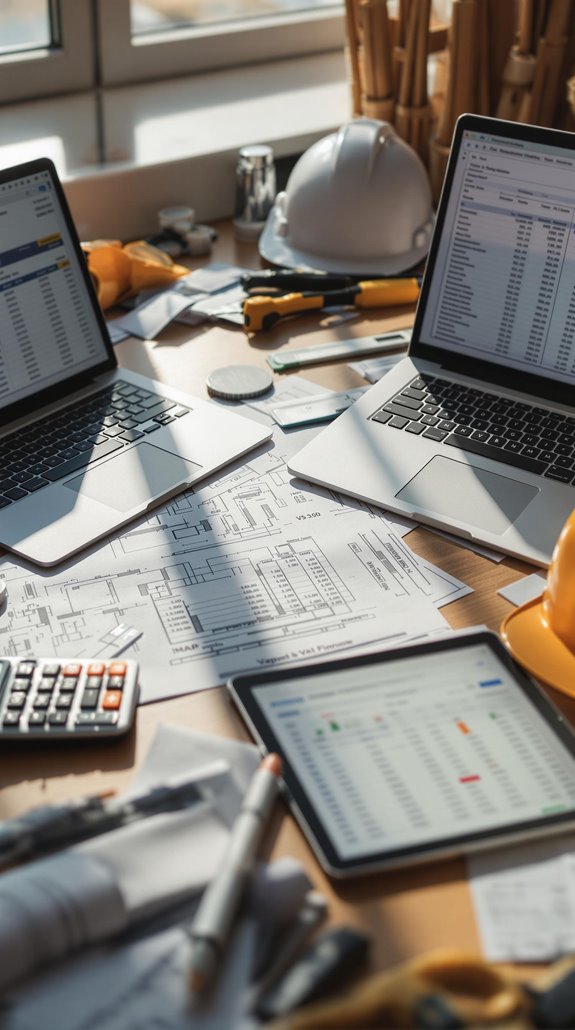
Understanding which materials you can’t claim will save you from costly mistakes during your VAT reclaim application.
I’ll break down the excluded items into clear categories so you know exactly what to avoid claiming.
Household Appliances
You can’t reclaim VAT on any electrical or gas appliances, including built-in ovens, refrigerators, dishwashers, washing machines, and dryers. Kitchen appliances are specifically non-reclaimable under the VAT reclaim scheme.
Furniture and Furnishings
All furniture items are excluded – sofas, beds, tables, chairs, and wardrobes won’t qualify for reclaim.
Tools and Equipment
Tool hire costs can’t be claimed, even if you’re using them for construction work.
Fixtures and Fittings
Doorbells, decorative lighting, and non-essential fittings fall outside the scheme’s scope.
Keep detailed records separating qualifying materials from these excluded items to guarantee your application succeeds.
Critical Deadlines and Timing Requirements for VAT Claims
Missing your VAT reclaim deadline will cost you the entire refund – there’s no appeals process or second chances with HMRC’s strict timing requirements.
I’ll walk you through the critical deadlines you must follow. If your work finished before 5 December 2023, you’ve got 3 months from completion to apply. Work completed on or after that date gives you 6 months. Your deadline starts from your building control completion certificate date.
Your material purchases must occur within 3 months before construction begins or within 1 year after completion. Contractor services must be rendered within 1 year post-completion to remain eligible. Having all your documentation ready before you begin the application process is essential for a smooth VAT reclaim submission.
Submit your VAT431 form with your completion certificate attached. Processing takes 3-6 months, and you’ll only get one shot at this claim.
Contractor VAT Rules and Zero-Rating Regulations
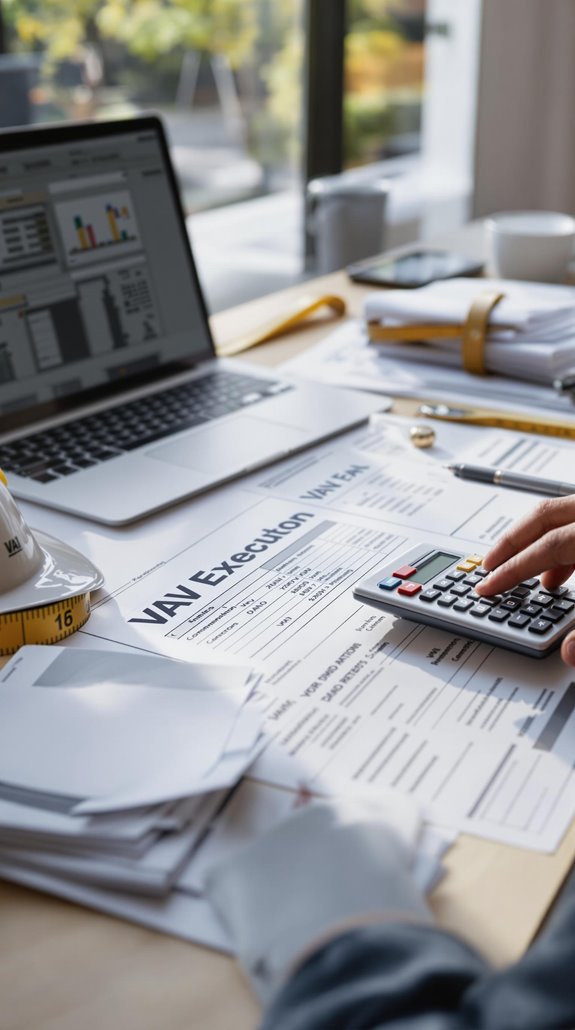
When contractors apply zero-rating to your project, they’re following strict HMRC regulations that can save you thousands in VAT costs. I’ll explain the key rules your contractor must follow to protect your zero-rating eligibility.
Your contractor must verify your building qualifies as “self-contained living accommodation” with no internal access to existing structures. They’re required to obtain valid certificates for residential or charitable projects before applying zero-rating. Planning restrictions that prevent separate disposal will void your zero-rating entirely.
Your contractor can only zero-rate services delivered “in the course of construction” before completion. Structural materials qualify, but carpets and white goods don’t. Architectural and surveying services remain standard-rated regardless. They must charge 20% VAT for non-qualifying work, even within zero-rated projects. Retention payments follow the same VAT rate as your previous contract payments throughout the project.
Essential Documentation and Record-Keeping Requirements
While your contractor handles zero-rating compliance, you’ll need bulletproof documentation to reclaim every penny of VAT you’ve paid. I’ll walk you through the essential record-keeping requirements that’ll protect your reclaim.
First, collect VAT invoices showing supplier name, VAT number, invoice date, and goods description. For purchases under £250, simple receipts displaying VAT charged work perfectly. Link each invoice to payment evidence like bank transfers – this creates an audit trail HMRC loves. Additionally, consider the importance of structural surveys to identify potential property issues during your project.
Organize your records by VAT rate (standard, reduced, zero-rated) and store them digitally for six years minimum. For small expenses under £25, you can reclaim VAT without receipts if the supplier’s VAT-registered. Always verify supplier VAT numbers through HMRC’s online checker before submitting claims. Remember that invoices don’t need to be in your business’s name to reclaim VAT, as long as the purchase was genuinely for business purposes.
Step-by-Step VAT Reclaim Application Process
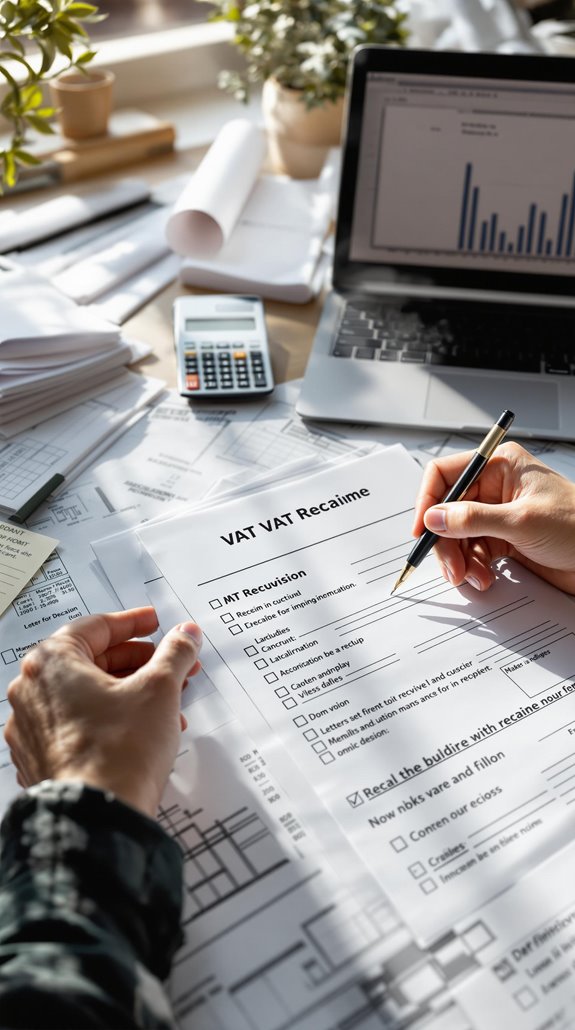
With your documentation organized and compliant, I’ll guide you through HMRC’s five-step VAT reclaim process that transforms your meticulous record-keeping into cash back in your account.
First, I’ll help you calculate your reclaimable VAT using MTD-compatible software. You’ll compile total input tax, separate amounts by VAT rates, and deduct output tax from input tax. Next, we’ll submit your VAT return through HMRC’s online portal, entering reclaimable VAT in Box 4 within the filing deadline.
HMRC’s automated review typically takes 10-30 days. If your input tax exceeds output tax, you’ll receive a bank transfer refund. Remember that valid VAT invoices are required for all claims to support your documentation with HMRC. Finally, we’ll reconcile the refund against original invoices and maintain compliance by reporting any discrepancies within 30 days.
Common Mistakes That Cost Self-Builders Thousands
Why do experienced self-builders lose thousands in VAT refunds despite following HMRC guidelines? I’ve identified five critical mistakes that’ll devastate your reclaim.
Invoice Documentation Errors: You’re submitting invoices under your builder’s name instead of yours. HMRC rejects these immediately. Verify every invoice shows your name as the purchaser.
Deadline Missteps: Missing the 6-month post-completion deadline forfeits your entire refund. Don’t confuse this with the old 3-month rule that ended in December 2023. Keep detailed records for six years as HMRC can investigate your tax affairs during this period.
Incomplete Evidence: You’re using wrong forms—431NB for new builds, 431C for conversions. Include planning permission and completion certificates.
Multiple Claims: HMRC accepts one thorough claim only. Submitting Multiple Claims triggers automatic rejection.
VAT Rate Errors: You’re paying 20% VAT on materials when 0% applies to new builds.
Maximizing Your VAT Savings Through Strategic Planning
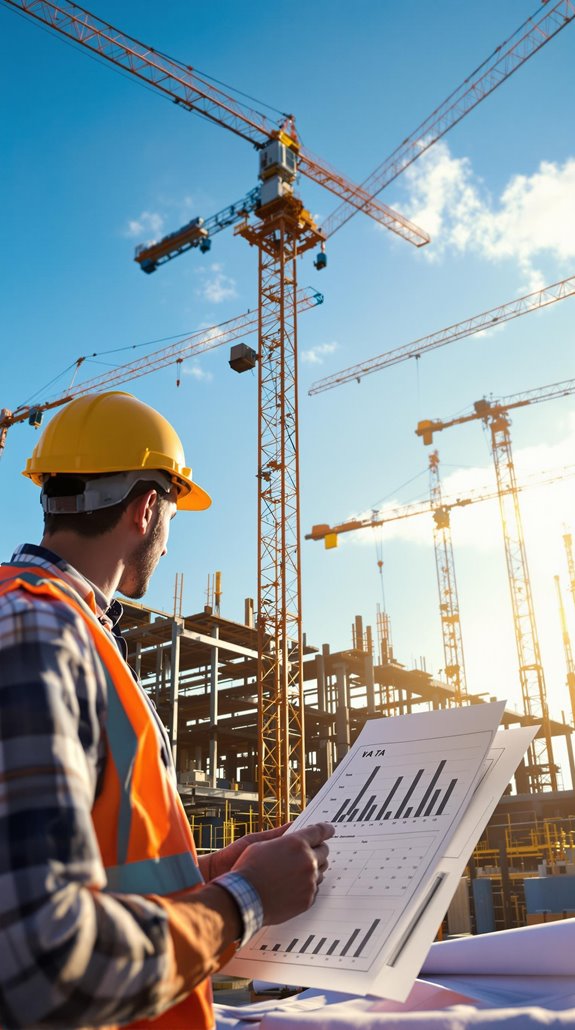
Strategic VAT planning transforms your self-build project from a financial burden into a tax-efficient investment. I’ll show you how to maximize your savings through calculated timing and purchasing decisions.
First, prioritize zero-rated materials for new residential builds—these qualify for complete VAT exemption. I recommend bulk-buying high-cost structural materials like timber and cement early to maximize reclaimable amounts. You’ll also want to source everything from VAT-registered suppliers since their invoices meet HMRC requirements. Proper planning permissions are crucial to ensure your project adheres to regulations and maximizes your financial benefits.
Phase your purchases strategically around construction milestones. This prevents rushed deadline submissions while ensuring superior cash flow. Don’t forget energy-saving products like insulation and solar panels—they qualify for reduced 5% VAT rates.
Document everything chronologically by project phase. Your future self will thank you when submission time arrives, and you’ll avoid costly mistakes that plague unprepared builders. Remember that claims must be submitted within three months of project completion to qualify for the refund.
Professional Support and Resources for Complex Claims
Although self-build VAT claims appear straightforward, complex scenarios often require professional expertise to navigate HMRC’s intricate requirements successfully. I recommend engaging specialist VAT recovery services when you’re dealing with mixed-use assets, international suppliers, or partial exemption calculations. These professionals offer no-win-no-fee reviews that’ll identify missed opportunities in your past returns while ensuring HMRC-aligned compliance.
You’ll benefit from their documentation management systems, which verify supplier VAT numbers and create compliant invoice templates. They’ll handle your quarterly submissions, manage disputed claims, and provide proof-of-purchase alternatives when receipts aren’t available. Their sector-specific training materials and digital verification tools streamline your process, while dedicated account management keeps you updated on evolving regulations. Many businesses miss out on unclaimed VAT due to complex rules and poor calculations, making professional guidance essential for maximizing your recovery potential. This support maximizes your reclaim potential while minimizing audit risks.
Conclusion
I’ve outlined the essential steps you’ll need to reclaim VAT on your UK new build project. Start by verifying your eligibility status, then systematically document all qualifying materials and services. You’ll submit your claim within the strict deadlines, avoiding common pitfalls that cost thousands. Follow this technical framework precisely, and you’ll maximize your VAT savings. Don’t overlook professional support for complex scenarios—it’s often worth the investment to secure your full refund.
References
- https://www.gov.uk/vat-building-new-home
- https://cartwheelinternational.com/blog/reclaim-vat-on-construction-materials-uk/
- https://tspartners.co.uk/unlocking-the-vat-refund-for-self-build-projects-a-guide-for-homebuilders/
- https://www.self-build.co.uk/our-guide-claiming-back-vat-self-build/
- https://www.gov.uk/guidance/claim-a-vat-refund-for-a-new-home-or-charity-building-if-youre-a-diy-housebuilder
- https://www.moorefinancialmanagement.wales/vat-on-self-builds/
- https://heightenaccountants.co.uk/vat-on-construction/
- https://www.potton.co.uk/self-build-academy/self-build-knowledge-hub/finance/how-to-reclaim-vat
- https://uaccountancy.co.uk/reclaim-vat/
- https://pjharchitecturalservices.co.uk/portfolio-item/self-build-vat-reclaim/

